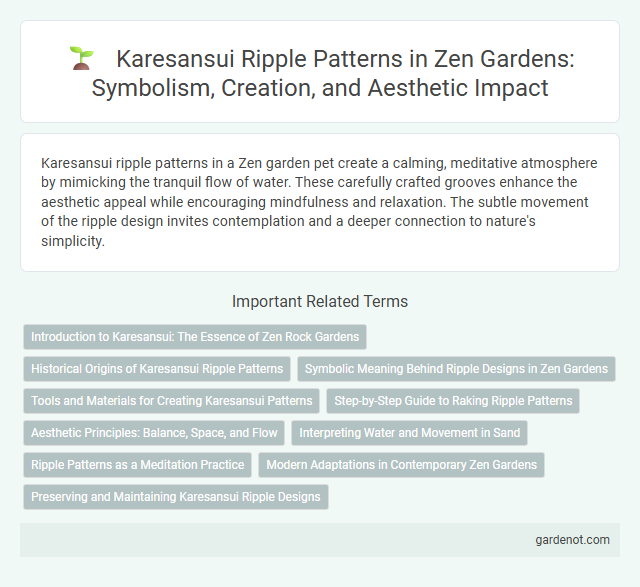Karesansui ripple patterns in a Zen garden pet create a calming, meditative atmosphere by mimicking the tranquil flow of water. These carefully crafted grooves enhance the aesthetic appeal while encouraging mindfulness and relaxation. The subtle movement of the ripple design invites contemplation and a deeper connection to nature's simplicity.
Introduction to Karesansui: The Essence of Zen Rock Gardens
Karesansui, a traditional Japanese rock garden, embodies the essence of Zen through its minimalist design and carefully raked gravel patterns that mimic rippling water. Each meticulously arranged stone and gravel ripple symbolizes natural elements, fostering meditation and inner tranquility. This art form emphasizes simplicity and balance, creating a serene space for reflection and spiritual awakening.
Historical Origins of Karesansui Ripple Patterns
Karesansui ripple patterns, integral to Zen garden design, originated during Japan's Muromachi period (1336-1573) as symbolic representations of water in dry landscapes. Influenced by Zen Buddhism, these carefully raked sand ripples embody concepts of tranquility and meditation, mirroring the natural flow of water and waves. The historical adoption of these patterns reflects a synthesis of spiritual practice and aesthetic principles central to Japanese cultural heritage.
Symbolic Meaning Behind Ripple Designs in Zen Gardens
Karesansui ripple patterns in Zen gardens symbolize the flow of water and the impermanence of life, reflecting Buddhist concepts of tranquility and mindfulness. These meticulously raked lines evoke the gentle movement of rivers or ocean waves, promoting meditation and inner calm. The ripple designs serve as a metaphor for the continuous flow of time and nature's subtle rhythms.
Tools and Materials for Creating Karesansui Patterns
Creating Karesansui patterns requires specialized tools such as a rake with evenly spaced tines, often made of bamboo or metal, to craft precise ripples in the gravel. Fine, angular gravel or crushed granite serves as the foundation, chosen for its ability to hold intricate patterns and evoke the flow of water. Careful selection and maintenance of these tools and materials ensure the enduring elegance and symbolic significance of the Zen garden's ripple design.
Step-by-Step Guide to Raking Ripple Patterns
Create precise Karesansui ripple patterns by starting with clean, dry sand in the Zen garden's rock bed. Use a specialized garden rake to draw parallel lines evenly spaced, maintaining consistent pressure for smooth, flowing waves that mimic water movement. Gradually layer additional curves and circular patterns around stones, enhancing the garden's tranquility and visual rhythm through deliberate, meditative strokes.
Aesthetic Principles: Balance, Space, and Flow
Karesansui ripple patterns embody the aesthetic principles of balance, space, and flow by creating harmonious visual rhythms through meticulously raked gravel. The carefully spaced ripples emphasize negative space, enhancing the garden's tranquility and guiding the viewer's gaze fluidly across the landscape. This interplay of balanced patterns and open space fosters a meditative ambiance rooted in Zen philosophy.
Interpreting Water and Movement in Sand
Karesansui gardens use carefully raked sand or gravel to mimic the ripple patterns found in water, symbolizing the flow of rivers, waves, or still ponds. The deliberate arrangement of these lines evokes a sense of calm movement, encouraging contemplation of natural water dynamics without the presence of actual water. This technique transforms static sand into a visual metaphor for fluid motion, embodying Zen principles of simplicity and mindfulness.
Ripple Patterns as a Meditation Practice
Karesansui ripple patterns in Zen gardens embody the principle of mindful meditation through their meticulously raked gravel or sand. These concentric and linear ripples mimic water movement, fostering tranquility and deep focus in practitioners as they engage with the garden. The deliberate creation and maintenance of ripple designs encourage present-moment awareness and mental clarity, integral to Zen meditation practices.
Modern Adaptations in Contemporary Zen Gardens
Modern adaptations of Karesansui ripple patterns in contemporary Zen gardens emphasize minimalist design while maintaining the traditional symbolism of water and tranquility. Designers use precise gravel raking techniques combined with innovative materials such as metal or glass elements to create dynamic visual contrasts. These adaptations enhance sensory experiences and integrate seamlessly with urban environments, promoting mindfulness in busy modern lifestyles.
Preserving and Maintaining Karesansui Ripple Designs
Preserving and maintaining Karesansui ripple designs requires careful attention to the precision and consistency of stone patterns and gravel lines that embody the essence of Zen aesthetics. Regular raking using specialized wooden tools helps prevent erosion and preserves the intricate wave-like patterns symbolizing water flow. Skilled gardeners ensure that each ripple is renewed seasonally while respecting the original design's balance and harmony.
Karesansui ripple Infographic

 gardenot.com
gardenot.com